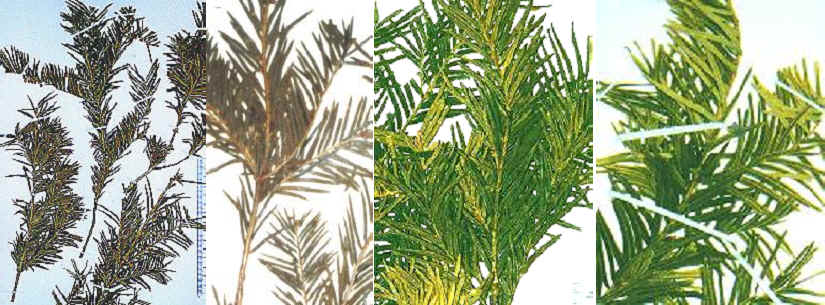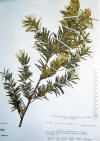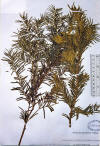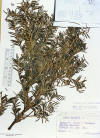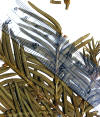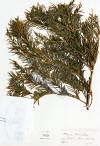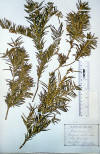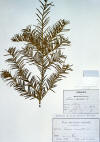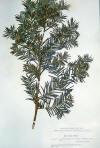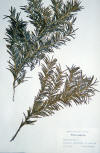|
1c.
Taxus baccata var. elegantissima. [hort. ex] [C.] Lawson et al. Abietineae—List
Pl. Fir Tribe No. 10, 82 (1851). Taxus baccata f. elegantissima
Beissner, Syst. Eintheil. Conif. 23 (1887). Taxus
baccata (var.) argentea Loudon ex Gordon, Pinetum 312. 1858.
Original material unknown. Elegant yew. Distribution: Euro-Mediterranean. Apparently trees, bark reportedly pale yellowish (Lawson et al. 1851); branches wide spreading (Krüssmann 1985) with isodichotomously divided, pendulous branchlets; bud-scales at abase of branchlets, deltoid, closely adpressed, not strongly nerved, similar in color to branchlets; leaves usually secund, spreading ±in two ranks but overlapping slightly, in hair-like tufts near apex of branchlets, linear, falcate, 2.2–3.5 cm long, 1.5–2.5 mm wide, drying dark almost blackish green above and rusty orange below, occasionally young leaves drying yellow, acute to acuminate, rarely obtuse. Seeds on branchlets of current season, cylindrical to subglobose. The elegant yew is characterized by leaves tapering gradually to an acute or acuminate apex, often curled inwards in the upper third of the leaf, and appearing in hair-like tufts near branch apices. Most herbarium specimens have leaves that appear dark—almost blackish green above—and rusty orange below, in contrast to leaves on live plants that have been described “striped pale yellow, later whitish” (Lawson et al. 1851; Rehder 1940), or green in shade to golden in sunlight (den Ouden & Boom 1965). Occasional herbarium specimens, however, seem to preserve the live color features. This variety occurs widely in Euro-Mediterranean mountains. (Atlas, Austria Alps, Taurus), perhaps most common in the west Taurus Mts. at elevations from 2000–2500 m; see Elwes & Henry (1906) and specimens cited below. Except for color, specimens from cultivation hardly differ from those collected in the wild (e.g., Rácz -Debreczy from arboretum in Budapest, US:-069543; HGT 884 from Greece, K), but labels on herbarium specimens may bear other names; e.g., f. washingtonii (Breslau, US: 1395577) and cv. ‘Aurea’ (Budapest, US: 3069544). Additionally, in horticulture only females were thought to belong to this this variety, while I include male specimens collected in the wild. Variety elegantissma is occasionally difficult to distinguish from var. glauca. The latter is usually identified by young leaves drying yellowish, whereas leaves of the elegant yew appear more rusty orange in color, and also thinner, although color differences may be related to the drying process rather than a natural color change. Specimens of cultivated plants of var. elegantissima overlap in features with those of var. glauca by the recurved branchlets and glaucous color, instead of leaf length, thickness and color differences among wild plants. Intermediates are distinguished by the angle at which leaves taper to apex, obtuse in var. glauca, acute to acuminate in var. elegantissima. The slightly narrower and longer leaves of var. elegantissima is correlated with their hair-like tufted appearance near apex of branchlets.
Leaves of the elegant yew were frequently found with anatomical
features that appeared less frequent in other varieties. These
include more stomata, the abaxial surface have marginal papillae near stomata bands
and on the midrib, the mesophyll
with an elongate network of
cells interconnected with occasional ellipsoidal or spherical cells, or
predominantly of dark spherical cells. There is a strong
similarity to the Himalayan T. contorta that generally differs by
the leaves appearing more dull olive green in color in dried specimens. Taxus baccata cv. 'Repandens' Parsons, Descr. Cat. Kissena Nurs. 92 (1887?), n.v.; T. baccata var. repandens (Parsons) Rehder in Bailey, Stand. Cycl. Hort. 6: 3316 (1917), Cult. Evergreens 187 (1923); T. baccata f. repandens (Parsons) Rehder, Bibl. cult. trees & shrubs 3 (1949). Type—undetermined. This cultivar may be a hybrid between var. elegantissima and T. baccata var. washingtonii. It is easily recognized by the flat-topped crown in which the overall shrubby habit is much wider than tall as shown in Chadwick and Keen (1976). The cv. ‘Repandens is commonly cultivated in the eastern United States. Further study is required to determine a type for cv. 'Repandens' and whether it deserves separate taxonomic status. The low habit and phyllotaxy are similar to T. baccata var. glauca, which Hatfield (1921) mentioned was in the “English yew” collection at the Wellesley Estate, whereas the upward secund leaves are more like those of var. elegantissima, which was not mentioned in Hatfield (1921). The cultivated plants differ from many native European plants in their leaves having a slightly broader abaxial marginal zone of rectangular smooth cells, 8–12 cells wide, and more stomata, 11–12 stomata rows/band, but more study is needed. Although var. elegantissima is considered typically a tree, I am uncertain whether I can distinguish shrub forms based strictly on herbarium material, therefore, cv. 'Repandens' is tentatively placed under var. elegantissima. Representative Specimens—Algeria: Chria near Blida, Swingle (NA: 236239); (Tell) Atlas de Blida, Reichenbach (K). Portugal: Serra Ljery? Yoller 61 (BM). France: Pyrenees, Willmott, Massonnet (K). Germany: Bavaria, Martius 1831 (PH). Hungary: Herb. Láng (PH). Austria: Tirol, Feeshal, ex Herb. Pichler (US: 347988, lower and top left specimens); Alps, collected 1863, ex Shulte Herb. (K). Slovakia: Tatra, Woloszczak (K). Greece: Hills N of Xant Is., HGT 884 (K). Denmark: Herb. Joh. Lange 1866 (K). Sweden: Dalsland, Gunnarans, Henriksson (K). Russia. Georgia: SW, Black Sea near NE Turkey, Adjarian, 900 m, Dmitrieva (NA). Czech Republic: Moravia Centralis, 4-450 m, Jirasek & Suza (K, US). Turkey: Taurus, Veselsky (BM). Cultivation—England: Kew, “var. washingtonianum” (K). Poland: Baenitz, ex Herb. Dendr., “f. washingtoni” (US: 1335577). Hungary: ex Herb. Mus. Hist. Nat 11417., in adnot. f. aurea (US: 3069544); ex Herb. Mus. Hist. Nat.11418, in adnot. ‘elegantissima’ (US: 3069543). Poland: Baenitz, ex Herb. Dendr., “v. erecta” (US: 139605); : Ziesch, ex Herb. Baenitz, “f. glauca Carr. = f. subglaucescens Jacq” (US: 1396503).
|
